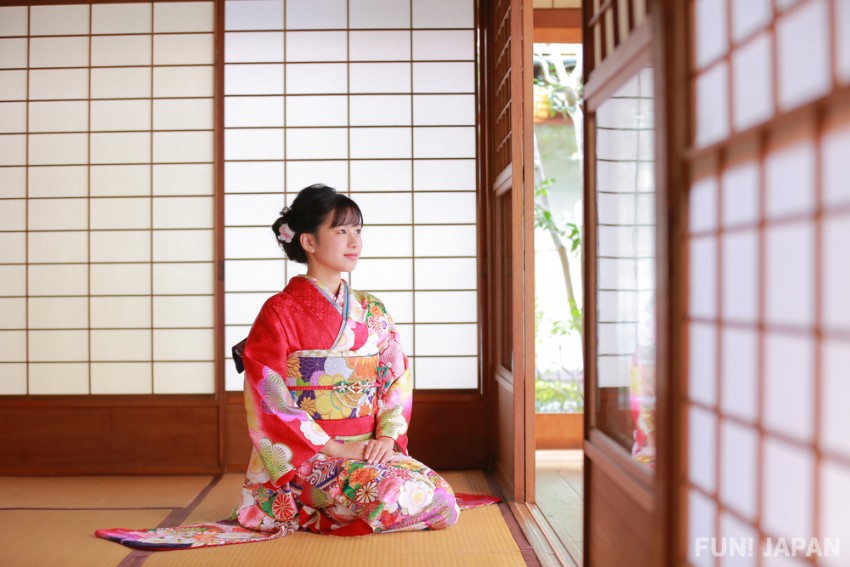
Kimono is known as one of Japan's national costumes. But what are the exact differences between kimono and yukata? Or are they actually the same? In this article, we will compare the differences between yukata and kimono from four perspectives, with a comparison chart that you can see at a glance at the end. Be sure to check the differences between kimono and yukata when you visit Japan!
What is a Japanese yukata and kimono? Let's compare their history!
First, let's unravel the history of yukata and kimono. Are there differences between them in terms of history and origin?
What is a yukata?

Yukata was originally called the "yukatabira" (湯帷子) and was worn by nobles during the Heian period (794 - 1185) for bathing. At the time, there was no custom of bathing naked like now. It is said that yukatabira that time act as a garment to soak up perspiration and prevent scalding by ensuring the skin was not directly exposed in a steam bath, as well as covering the nakedness. In those days, cotton was considered a luxury item, so it was common to make yukatabira from hemp.
Since middle Edo period (1603 – 1868), Japanese people started taking baths naked, and cotton materials became more accessible by the general public. With the spread of public baths and the fact that cotton material absorbs sweat and is breathable, yukatabira came to be used to wipe off sweat after taking a bath or as a nightgown.
After that, yukatabira came to be used as a homongi (訪問着 - visiting dress) that can be worn outside. Meanwhile, the name 'yukatabira' was shortened to 'yukata'. It is said that yukata became to gain popularity as a modern summer outfit during the Meiji period (1868 - 1912).
What is a kimono?
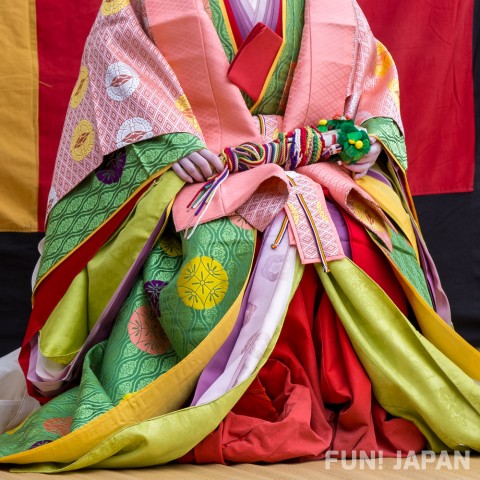
“Kimono” originally meant “clothes” in Japanese, but in recent years, kimono denotes a specific type of "traditional Japanese garment". The prototype of today's kimono is said to be kosode (小袖), which was undergarments in the Junihitoe (十二単 - twelve layers clothes) worn by high-ranking nobles in the Heian period (974 – 1185). As time went by, kosode became popular as an outerwear instead of underwear, and kimonos of various shapes and colors were made. However, as the cultures of other countries spread to Japan, lifestyles and clothing styles became westernized. Western clothes have become the mainstream of clothing in modern times, leading to fewer opportunities to wear a kimono even for Japanese people.
Here is an article on traditional kimono types: Traditional Kimono: A Guide to Formal Dress Etiquette
Kimono is a word that refers to "things to wear". In modern times, it also has the meaning of 'Japanese garment', thus yukata is also a kind of kimono. The type of kimono you wear depends on the occasion. From here on, let's take a look at the differences between each of the four perspectives: occasions, materials, accessories, and how to wear.
①Yukata vs Kimono: usage and occasions

In modern Japan, kimono is worn for formal occasions and yukata is worn for casual occasions.
It wasn't until the Meiji period (1868 - 1912) that yukata rooted as a summer kimono. Born from everyday situations, yukata is not suitable for formal occasions but is usually worn at summer events such as festivals, fireworks displays, and casual dinner parties. Yukata is also the clothing provided at hot spring inns (ryokan).
On the other hand, kimono is worn for celebrations such as weddings and parties, as well as formal occasions such as hatsumode (first visit of the year to temple/shrine), coming-of-age ceremonies, and graduation ceremonies. For example, "shiromuku" (白無垢) and irouchikake (色打掛) worn by brides at weddings, and "furisode" (振袖) worn by new adults at coming-of-age ceremonies. In addition, some people wear kimono as formal attire for traditional performing arts such as Kabuki, art museum visits, tea ceremonies, and Japanese dance lessons.
②Yukata vs Kimono: fabrics
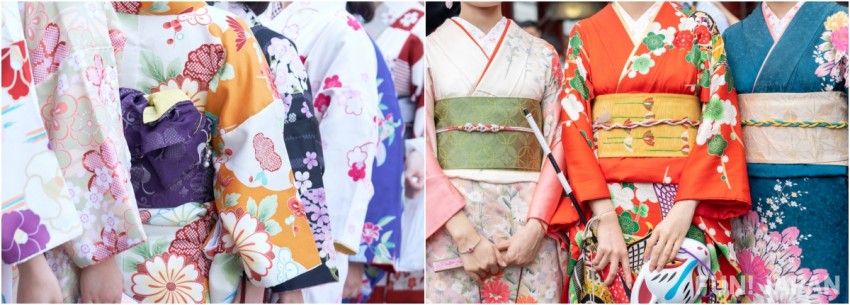
Next, let's introduce the difference between the materials of yukata and kimono. How much do you know about the fabrics used for kimono and yukata?
A yukata is designed to keep you comfortable during the hot Japanese summer. Naturally, materials that are soft-touch and can sweat-absorbing are preferred. In the past, linen yukatas were the mainstream, but now cotton ones have won a majority. There are also yukatas made with mixed fabrics of cotton and linen, while polyester yukatas are often sold because they are easy to care for.
Among various kimono materials, silk is considered to be the finest fabric. There are various price ranges and types of kimono, and fabrics such as linen, wool, and polyester are used accordingly.
Yukata
- Cotton: the standard material for yukatas as it absorbs sweat and moisture well and can be washed.
- Hemp: a coarser material that wrinkles more easily than other fabrics, but is softer to the touch and has higher absorbency and wicking capability.
- Polyester: gentle on the skin and absorbs sweat, and dries quickly, making it easy to wear.
Kimono
- Silk: lustrous and soft. Widely used for tomesode (留袖 - standard kimono) and furisode (振袖 - kimono with long dangling sleeves).
- Hemp: thin and pliable. Mainly used for summer kimonos.
- Polyester: a chemically synthesized fiber designed to have tensile strength. Since it is washable, it is used for various types of kimonos.
- Wool: thick, wrinkle-resistant, and stain-resistant. It is often used for winter kimonos.
③Yukata vs Kimono: accessories
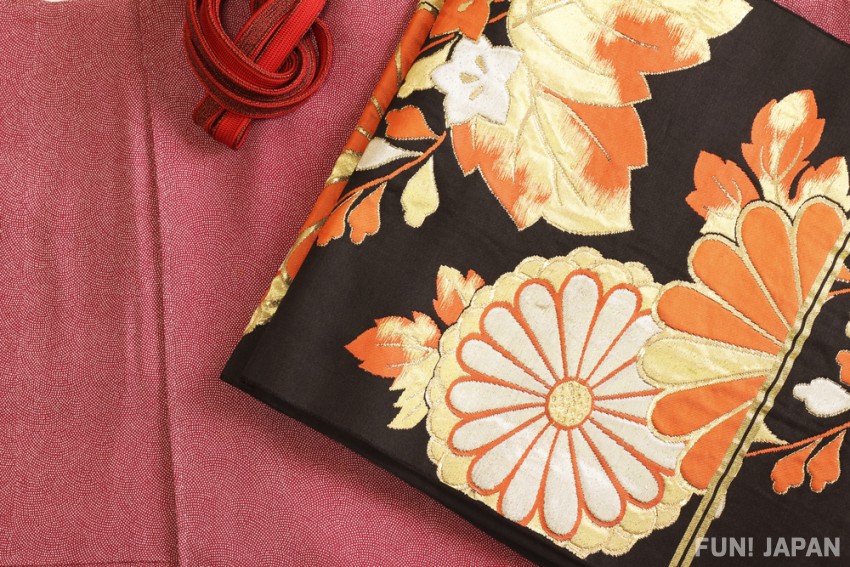
It may be difficult to tell the differences between yukata and kimono at first glance, but in fact accessories other than the fabric itself and what you put on your body are also different. Now let's learn about the differences!
Obi (waistband)
In the case of a yukata, a han-haba obi (半幅帯 - half-width waistband) is generally used. As other obis are thicker that might give a sultry impression, it is common to arrange and tie a "han-haba obi", which is half the width of fukuro-obis (袋帯) or Nagoya-obis (名古屋帯). Basically, obi accessories such as obiage (帯揚げ) and obijime (帯締め) are not often used (however, they may be attached as part of the yukata dressing arrangement).
For kimono, obis that are wider than those commonly used for yukatas, such as formal fukuro-obis and Nagoya-obis that are often worn for going out, are used. In addition, you can change the pattern and color of the obi according to the place you visit or the season, and choose the obi to match your kimono. Each pattern and color of the obi has its own meaning, so be sure to check the meaning and arrange the outfit to suit your taste!
Hair ornaments
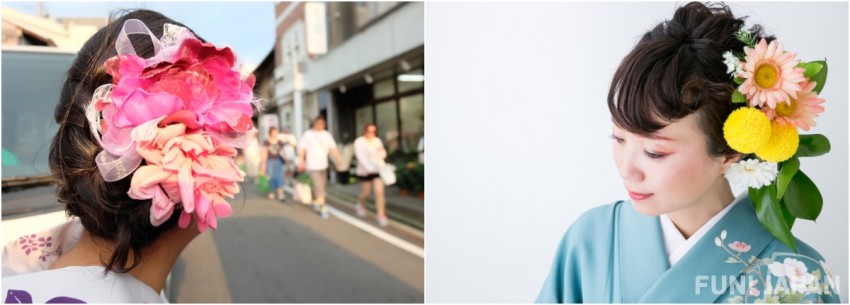
For both yukata and kimono, it is common to wear hair in an up-style hairdo.
However, in the case of wearing a yukata, hair ornaments that stand out too much can make you look unbalanced and childish.
On the other hand, kimono is often worn for celebrations such as weddings and formal occasions, so flashy hair ornaments may be used depending on the design and color of the kimono.
Footwear
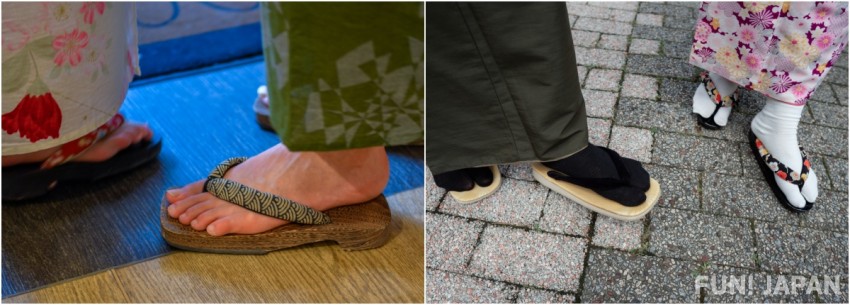
A yukata usually comes along with a pair of geta (下駄 - wooden shoes or Japanese clogs) on your feet. It is common to wear geta with bare feet. On the other hand, a kimono pairs with zori (草履 - sandals). It is common to wear tabi (足袋 - split-toe socks) just like socks and pair them with zori.
④Yukata vs Kimono: how to wear
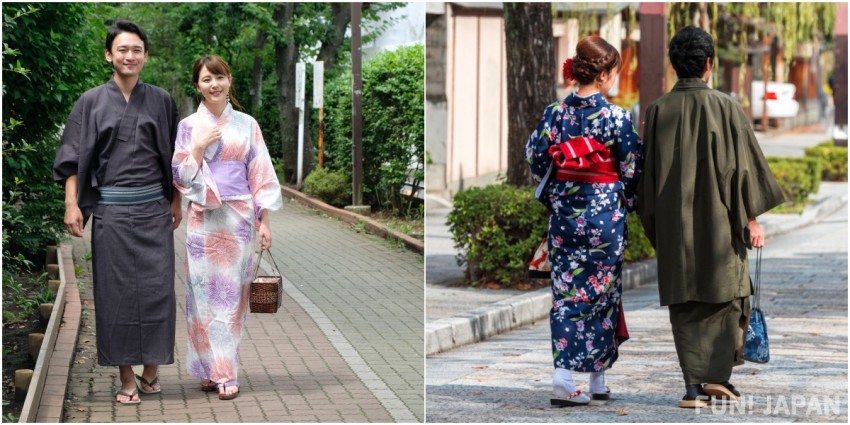
Lastly, here comes the differences in how to wear a yukata and a kimono.
When wearing both kimono and yukata, the collar on the right hand side should be fitted to the skin first, and the collar on the left hand side should be in front of the costume.
A yukata is worn on bare skin. Since it was originally worn after bathing, it was common to not wearing anything inside the yukata. However, nowadays, when you wear a yukata as a visiting dress for fireworks displays or summer festivals, it is normal to wear underwear or a 'hadajuban' (肌襦袢 - skin undergarment) like when wearing a kimono. Yukata takes less time and effort to put on than kimono, so if you're going to put on a Japanese garment at home by yourself, we recommend wearing a yukata.
A kimono is rarely worn on bare skin. Japanese people wear undergarments such as hadajuban and nagajuban (長襦袢). . Hadajuban is like underwear, and nagajuban is a kimono worn under a kimono to make it look like you are wearing layers of kimono. There are more processes of dressing than yukata.
Let's see the differences at a glance! Yukata v.s. Kimono Comparison Chart
| Yukata | Kimono | |
| Occasions | casual occasions | formal occasions |
| Wearing situations (examples) | festivals, fireworks displays, summer events, etc. | celebrations such as weddings, parties, hatsumode, coming-of-age ceremonies, graduation ceremonies, etc. |
| Fabrics | cotton, hemp, polyester | silk, hemp, polyester, wool |
| Obi | use half width waistband called han-haba obi | commonly use fukuro-obi and Nagoya-obi emphasis on the pattern and color of the obi |
| Footwear | wear geta on barefoot | wear zori with tabi |
| How to wear | when wearing a yukata as a 'homongi' visiting dress, it is common to wear an undergarment (Hadajuban). (Nagajuban is not required) | wear undergarments such as hadajuban and nagajuban |
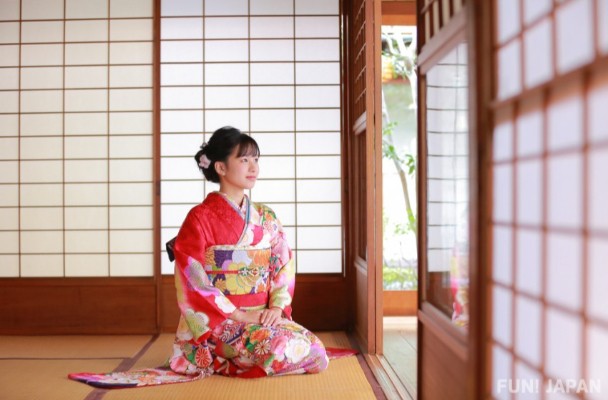
Comments